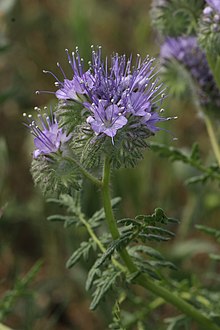| Phacelia | |
|---|---|

| |
| Phacelia tanacetifolia | |
| Scientific classification | |
| Kingdom: | Plantae |
| Clade: | Tracheophytes |
| Clade: | Angiosperms |
| Clade: | Eudicots |
| Clade: | Asterids |
| Order: | Boraginales |
| Family: | Boraginaceae |
| Subfamily: | Hydrophylloideae |
| Genus: | Phacelia Juss. (1789) |
| Type species | |
| Phacelia secunda | |
| Diversity | |
| About 200 species | |
| Synonyms[1] | |
| |
Phacelia (phacelia, scorpionweed, heliotrope) is a genus of about 200 species of annual or perennial herbaceous plants in the borage family, native to North and South America. California is particularly rich in species with over 90 recorded in the region. [2]
The genus is traditionally placed at family rank with the waterleafs (Hydrophyllaceae) in the order Boraginales. The Angiosperm Phylogeny Group, recognizing that the traditional Boraginaceae and Hydrophyllaceae are paraphyletic with respect to each other, merges the latter into the former and considers the family basal in the Euasterids I clade. Other botanists[3] continue to recognize the Hydrophyllaceae and Boraginales after analysing the secondary structure of the ITS1 genetic region rather than its sequence for these higher taxonomic levels. This placed Phacelia within the Hydrophyllaceae.[3] Further molecular taxonomic analysis of the Boraginales has divided the Boraginales in two and placed Phacelia among the monophyletic herbaceous Hydrophyllaceae in Boraginales II.[4]
The genus includes both annual and perennial species.[2] Many have been cultivated as garden and honey plants.
There are reports that glandular hairs of stems, flowers and leaves of some species of Phacelia secrete oil droplets that can cause an unpleasant skin rash (contact dermatitis) in some people, specifically from P. brachyloba,[5] P. campanularia,[6] P. crenulata,[5][7] P. gina-glenneae,[8] P. grandiflora,[5] P. ixodes,[6] P. minor,[9] and P. pedicellata.[5][6] The major contact allergen of P. crenulata has been identified as geranylhydroquinone and of P. minor as geranylgeranylhydroquinone.[9]
The mining bee Andrena phaceliae is a specialist pollinator of this genus in the Eastern United States
- ^ Phacelia Juss. Plants of the World Online. Retrieved 30 July 2024.
- ^ a b Gilbert, Cynthia; Dempcy, John; Ganong, Constance; Patterson, Robert; Spicer, Greg S (2005). "Phylogenetic Relationships within Phacelia subgenus Phacelia (Hydrophyllaceae) Inferred From Nuclear rDNA ITS Sequence Data". Systematic Botany. 30 (3): 627–634. doi:10.1600/0363644054782251. S2CID 85948949. Retrieved 11 November 2020.
- ^ a b Gottschling, M; Hilger, H H; Wolf, M; Diane, N (2001). "Secondary Structure of the ITS1 Transcript and its Application in a Reconstruction of the Phylogeny of Boraginales". Plant Biology. 3 (6): 629–636. Bibcode:2001PlBio...3..629G. doi:10.1055/s-2001-19371. S2CID 260252906. Retrieved 11 November 2020.
- ^ Weigend, Maximilian; Luebert, Federico; Gottschling, Marc; Couvreur, Thomas L.P.; Hilger, Hartmut H.; Miller, James S. (2013). "From capsules to nutlets—phylogenetic relationships in the Boraginales". Cladistics. 30 (5): 508–518. doi:10.1111/cla.12061. PMID 34794245. S2CID 11954615.
- ^ a b c d Munz, Phillip A (1932). "Dermatitis produced by Phalecia (Hydrophyllaceae)". Science. 74 (1965): 194–195. doi:10.1126/science.76.1965.194.a. PMID 17795320. S2CID 239784768. Retrieved 11 November 2020.
- ^ a b c Reynolds, Gary W.; Epstein, William L. (1986). "Unusual contact allergens From plants in the family Hydrophyllaceae". Contact Dermatitis. 14 (1): 39–44. doi:10.1111/j.1600-0536.1986.tb01150.x. PMID 3948508. S2CID 30674931.
- ^ Berry, C. Z., et al. (1962). Dermatitis venenata from Phacelia crenulata. Archives of Dermatology 85(6), 737-39.
- ^ Edgar, Leith. "Service Botanist Discovers Native Colorado Flower". US Fish and Wildlife Service. Retrieved 11 November 2020.
- ^ a b Reynolds, Gary; Epstein, William; Terry, Diane; Rodriguez, Eloy (1980). "A potent contact allergen of Phacelia (Hydrophyllaceae)". Contact Dermatitis. 6 (4): 272–274. doi:10.1111/j.1600-0536.1980.tb04929.x. PMID 7398286. S2CID 42561206.